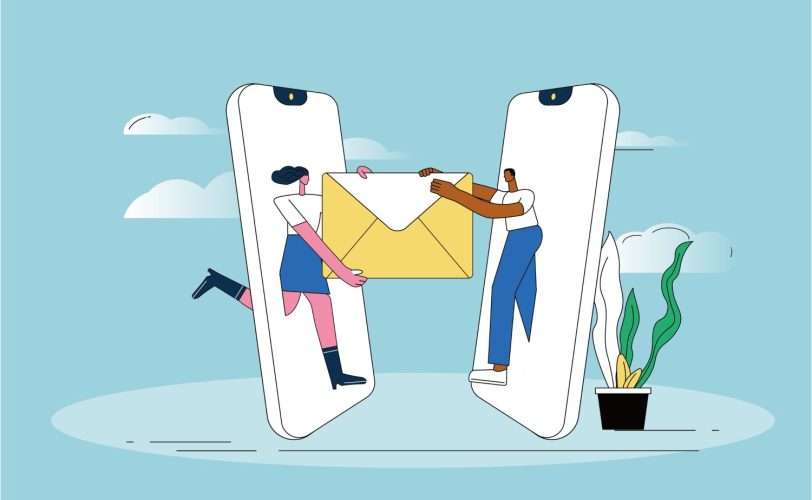5 Email Marketing Campaigns Every Small Business Needs

Stop running email experiments that waste your time — here are five email nurture journeys your small business marketing team needs to build now.
Ever built 20 email marketing campaigns only to find that only one works? It’s frustrating, right? For small and medium-sized businesses (SMBs), this can feel even more scary. The truth is, successful marketing isn’t just driving people to your website and getting their email information; it’s inviting them on the entire customer journey to become part of your business family.
SMBs must adopt a customer-centric mindset and implement effective email nurture journeys that guide prospects from interest to purchase. We’ll explore the essential email nurture journeys for SMB marketing that can help you build stronger customer relationships and drive sustainable growth. So, let’s dive in.
What you’ll learn:
- What’s an email nurture journey?
- Top email nurture journeys SMBs should implement
- Measuring success for SMB email nurture journeys
- Best practices for building effective nurture journeys
- Kickstart your email marketing campaign for SMBs
What’s an email nurture journey?
An email nurture journey is a series of targeted emails designed to engage, educate, and convert prospects into customers over time. It’s easy to say that SMBs often have limited resources, making it essential to optimize marketing efforts.
Here’s an example: Johnny lands on your website -> Johnny subscribes to your content -> Johnny receives an introductory email from you -> Johnny then receives another email three days later offering your services -> Johnny clicks and purchases your services -> and now Johnny is a customer. You want Johnny to be a customer for life, so he will receive many different emails from you as a business. That’s an email journey, and oh, what a journey it is.
Automating nurture journeys helps you reach broader audiences without a significant jump in marketing costs. You can consistently provide relevant content that resonates with the prospect, leading to increased engagement and retention. The frequency of emails you send depends on what feels right for your audience, offering, or service. The goal is to balance them out so that they don’t feel overwhelmed. These journeys can lead to higher conversion rates since nurtured leads often make larger purchases. So, with a little help from the right tools (and these tips), you can increase your ROI with an email campaign alone.
Get your quick-guide to emails for SMBs right here
Make every email count. Learn how to create effective email nurture campaigns that keep your prospects informed and engaged at every stage of their journey.



Top email nurture journeys SMBs should try
Say goodbye to running email experiments that will waste your time — here are five email nurture journeys your small business marketing team needs to build now.
1. The welcome series nurture
A prospect’s interest in your brand is at its peak right after they sign up. Needless to say, it’s the perfect time to make a great first impression. A welcome series is a set of automated emails triggered as soon as someone joins your email list. It introduces your brand, sets clear expectations, and shows the value they’ll get by sticking around.
Welcome emails have an average open rate of 83.63% and a click-through rate (CTR) of 16.6%, both significantly higher than standard promotional emails. That’s why it’s important to make these early emails count by telling a story that resonates. Wondering if you should sell or not? Our advice is to use your welcome series as a way to nurture interest that eventually leads to a purchase. Build trust with every interaction.
For example, address a common challenge and educate your users on why it exists. Position your brand as the answer to the challenge you’ve outlined and focus on showing what the prospect stands to gain.
2. The top-of-mind nurture
Top-of-mind email nurture is a series of emails designed to keep your brand visible and relevant to potential customers over time. Instead of pushing for a quick sale, these emails share helpful, interesting content that builds trust and familiarity, so when prospects are ready to make a decision, your brand is the first that comes to mind.
Imagine your favorite coffee shop sending you weekly updates on new brews and seasonal treats, or a popular retail store sharing “insider access” to upcoming sales and style tips tailored just for you. The key is to stay in touch with a prospect who may be a good fit but is not yet sales-ready.
To create a top-of-mind nurture campaign, your small business should use educational and research-based content that establishes your company as a trusted source. You can include offers like webinars that explore trending topics in your industry, or content that shows how others are using your product. All you have to do is think of what free content your audience will find valuable.
Once you feed your customers content that’s helpful and not salesy, create drip emails and sprinkle in calls-to-action (CTAs) to entice them to want more. Again, the cadence depends on the audience, service, and offering. Use your intuition on how often you should send these. Every three days feels right for most campaigns.
Take the guesswork out of it and use artificial intelligence (AI) to help you here. AI tools are making it easier to send emails at just the right moment. For example, Einstein AI analyzes past engagement patterns and automatically selects the best time to reach each contact, helping you boost open rates and overall engagement.
3. The in-trial nurture
An in-trial nurture email journey is a series of automated emails sent to users during their trial period to guide them through the product, highlight key features, and encourage them to become paying customers.
Most B2B companies have a trial period so users can take a test drive before making their customers actually purchase For example, at Salesforce, we have a 14-day free trial to try out our CRM for small business — Salesforce Starter Suite.
Before our team creates content for an in-trial nurture, we do a ton of research. As a marketer, you want your product’s action triggers to connect to your marketing automation. This will help you send triggered emails based on users’ actions versus a time-based email journey. Gather customer feedback by setting up focus groups with customers or sending out a survey.
Along with identifying actions that are likely to lead to conversions, look for features that help create habits for your customers. Which features will make users want to log in more frequently? How do you use emails or even in-app messaging to encourage those actions? Asking yourself these questions will help you craft a successful in-trial nurture triggered by product actions.
4. The cart abandonment series nurture
A cart abandonment email nurture journey is a set of automated emails sent to customers who left items in their online cart without buying. These emails remind them of their interest and encourage them to complete their purchase.
Cart abandonment is a major revenue drain for many small businesses, especially in ecommerce. Nearly 70% of online shopping carts are left behind before purchase. With email accounting for 77% of marketing messages sent, in retail and consumer goods, it’s a key channel for recovering lost sales.
To maximize these conversions, you need to send a series of emails, reminding customers of what they left behind without coming on too strong. Sending three abandoned cart emails can increase orders by 69% compared to just one email. The first email sent one hour after the cart is abandoned, has a conversion rate of about 6.33%.
Here’s what to keep in mind for an effective cart recovery series:
- Catchy copy: Grab their attention with a subject line that’s direct and engaging, like, “Still Interested? Your Cart Awaits!”
- Create urgency: Letting customers know that items are in high demand can encourage them to complete their purchase faster.
- Offer promotions: If you can, include a small discount or free shipping to incentivize the purchase. Even a small perk can be the nudge they need to check out.
- Include easy payment: Finally, make sure to include a clear, prominent payment button in every email. It’s essential to streamline the checkout process and reduce any friction.
5. The upsell or cross-sell nurture
The upsell or cross-sell nurture email journey is a series of targeted emails that suggest products to existing customers based on their purchase history, aiming to increase their lifetime value.
Upsell and cross-sell nurtures can help improve the customer’s lifetime value. All you have to do is create a nurture campaign targeted to existing customers, then provide them with information and incentives to expand the list of products they currently use.
With these nurtures, you’re already at an advantage because you’re talking to your biggest fans — not cold leads. In fact, nearly a third of sales teams cite upsells and cross-sells as a top revenue source. To maximize their impact, be intentional with your content and send relevant information on specific products or services that would be beneficial to a specific client segment. Personalized recommendations within this nurture type are the key to success — use variable tags or dynamic content to ensure the right customers receive the right content.
Salesforce Starter makes it easy with smart segmentation, which helps you send each customer exactly what’s most valuable for them. Also, the drag-and-drop email builder lets you create beautiful, mobile-friendly emails with ease, using custom templates and interactive elements. The best part? Your customers get a tailored experience that feels personalized, not pushy, helping you build stronger connections.
AI for your SMB
Measuring success for SMB email nurture journeys
Tracking the success of your email nurture journeys is essential for you to see what’s working and what needs fine-tuning. You can monitor key metrics like open rates, click-through rates, and conversions to see how effectively your emails engage your audience. Find out what resonates with customers and make quick adjustments that drive better results.
Get an SMB marketing tool, so you have a unified view of your email performance. Seeing the big picture in one dashboard gives you clarity and control to refine your nurture strategy with confidence. Isn’t it cool to have everything in one place, from first contact to purchase? This way, you can easily manage different types of emails, like promotional, transactional, and triggered messages, while keeping them on-brand and GDPR-compliant. It’s a time-saver that also keeps your communications consistent, even with a small team.
Best practices for building effective nurture journeys
If you’re just starting out, email marketing can feel a bit overwhelming. To make things easier, here are some best practices that will set you up for success.
Bring AI to the inbox
For SMBs, generative AI within an AI-powered CRM can simplify email creation, delivering consistent, on-brand messages without the heavy lifting. The good part? You don’t have to waste time wondering what to send. With just one AI prompt, you can generate data-driven subject lines and body copy, whether you’re crafting fresh emails or updating old ones.
Personalize every message
It’s no secret that generic emails don’t resonate with anyone. According to Salesforce’s State of Marketing report, 84% of marketers use personalized emails, with 54% delivering fully customized content. Craft your message to feel like it’s coming from a friend who gets you, not a bot blasting out mass emails. Use personalization to include names, recommend products, or bring in specific details that match your reader’s interests. The more relevant your email, the more likely it’ll spark interest and action.
Test, test, test, and then optimize
If you’re not testing your email journeys, you’re guessing. A/B test everything you can — subject lines, send times, visuals, and CTA buttons — to see what resonates most with your audience. Track results, tweak accordingly, and repeat. Don’t shy away from using AI in your small business to gain deeper insights and optimize your strategy.
Kickstart your email marketing campaign for SMBs
Email nurture journeys make it easy for small businesses to stay connected and build lasting relationships with customers. With CRM and AI in the mix, you can track each customer’s journey and deliver personalized experiences — without the extra effort.
Salesforce Starter gives you all the essentials to get rolling. It’s an all-in-one CRM designed specifically for SMBs, covering marketing, sales, service, and commerce needs. Starter is easy to set up and simple to use, letting your team focus on growing business.





























